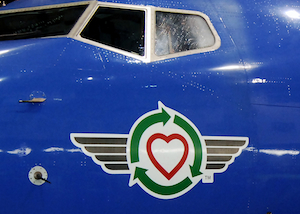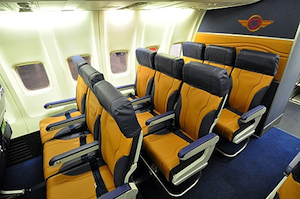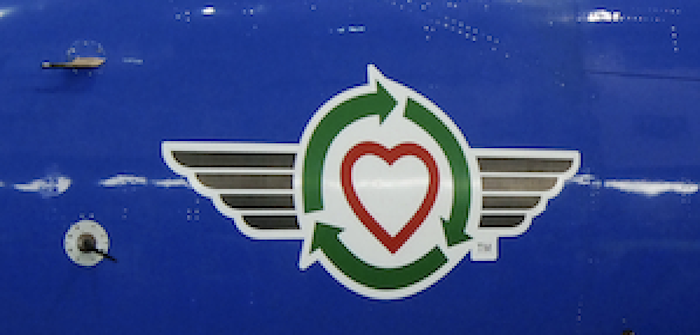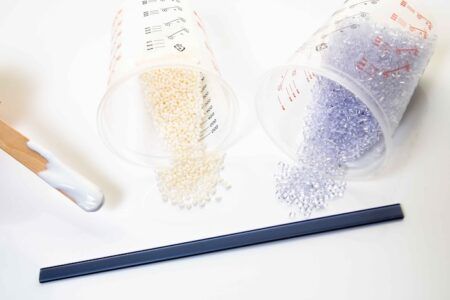
In the decades-long search to save fuel, every part of the aircraft has been re-examined and every pound re-evaluated. Following a two-year trial, in 2011 Southwest Airlines made changes to the interiors of its Boeing 737s having found weight-saving technology for seats and carpeting that was worth the price, and onboard internet technology that was worth the weight. From seat covers to carpet tiles, the changes could set new sustainability standards for aircraft interiors.
 Southwest Airline’s ‘green plane’ (tail number WN222) started in 2009 when the four-year-old aircraft lost 226kg (500 lbs) with the installation of cutting-edge materials that are lighter, easier to maintain and in some cases reusable. WN222 has the same single-class 137-seat cabin configuration as the rest of the Southwest fleet. The weight savings were expected to provide a 10,000 gallon-per-aircraft fuel saving each year.
Southwest Airline’s ‘green plane’ (tail number WN222) started in 2009 when the four-year-old aircraft lost 226kg (500 lbs) with the installation of cutting-edge materials that are lighter, easier to maintain and in some cases reusable. WN222 has the same single-class 137-seat cabin configuration as the rest of the Southwest fleet. The weight savings were expected to provide a 10,000 gallon-per-aircraft fuel saving each year.
“The direction we are going in the cabin is revolutionary,” stated Marilee McInnis, a spokesperson for Southwest. “It takes a long time and it’s not something that happens easily but we wanted to eliminate waste and get weight and fuel savings. We think it is the way of the future and we are excited with the results.”
As part of the Southwest challenge, several materials manufacturers agreed to redesign existing products for airline application. Izit Leather (a textile-backed, polyurethane-coated artificial leather) was being used on walls, headliners and some seating on business jets as long ago as 2002, explained Drew Clabough of Izit Leather based in Illinois. This toe in the water piqued the company’s interest in creating a product certified for use on airliners that was light but able to hold up under heavy passenger use.
“We had never considered putting the product on commercial airline seating,” said Clabough. “So we went back to square one and looked at developing a new product that would perform better across the board in all areas. That’s what we have now.”
Side-by-side comparison
 Whether Izit Leather is as durable, washable and impervious to stains and abrasion as Clabough claims will be determined by Southwest, which did a literal side-by-side test – with Izit on one side of the aisle and E-Leather seats on the other. E-Leather, based in the UK, is one step ahead of Izit in that it has a faux leather already in use on two airlines – North American in the US and Jet2.com in the UK according to the company’s website.
Whether Izit Leather is as durable, washable and impervious to stains and abrasion as Clabough claims will be determined by Southwest, which did a literal side-by-side test – with Izit on one side of the aisle and E-Leather seats on the other. E-Leather, based in the UK, is one step ahead of Izit in that it has a faux leather already in use on two airlines – North American in the US and Jet2.com in the UK according to the company’s website.
“We are surveying customers on the comfort,” McInnis said of the seat covers. How well they withstand the grit and wear of 100 million travellers each year, how easily they clean and how long before they wear out are also factors in the analysis. Southwest replaces covers about every four years according to McInnis. “We can extrapolate how long the seat covers will last based on the wear we’re seeing in the two years they’ve been on the plane.”
Southwest is not tinkering with the composition of the seat pan padding as are some other airlines, however it is using a lighter weight fill from Greiner PURtec in the back of the seat to reduce weight. There are two other seat-based revisions: the plastic rub strips have been replaced with lighter, recyclable aluminium and the rigid plastic life vest containers have given way to equally environmentally friendly canvas pouches. But the most sweeping change on the Southwest green plane is on the floor.
Square deal
In 2006, at the Payload Concept Center in Everett, Washington, USA, Boeing installed eco-friendly carpet tiles from InterfaceFLOR, a Georgia-based manufacturer of industrial carpet squares. Boeing executives were so pleased with the product, they approached InterfaceFLOR to see if it was interested in modifying the tiles for aircraft cabins. Jeanne Yu director for environmental performance at Boeing, recalls the engineers saying: “’This went in pretty nicely, why don’t we consider it for aircraft?’ And InterfaceFLOR was excited about doing that.”
In what Yu considers a radical change for sustainable interiors, Southwest installed the carpet tiles on its test aircraft. There are several advantages to the tiles over rolled carpet. The squares are lighter than traditional carpet and when damaged only the affected tiles need to be replaced.
Initially, it was difficult to keep the appearance of old and new squares consistent: “When you remove and replace tiles, you have to make sure the new carpet tile meshes with a carpet that has aged,” explained Yu. IntefaceFLOR resolved the problem by incorporating a variety of shades in each tile to create the illusion of a uniform colour. Another benefit to modular carpet is that it can be installed and removed with the seats in place.
“This is a unique product,” said Steve Arbaugh, vice president for brand marketing alignment and experience for InterfaceFLOR of the SKY-TILES, recalling that the company won the Crystal Cabin Award in the ‘greener cabin, health and safety’ category at the Aircraft Interiors Expo in Hamburg in 2008. Modular carpeting is not a new concept; it has been the raison d’être of InterfaceFLOR for 40 years and is sold in 110 countries.
Still, producing a durable, recyclable, removable carpet tile for home or office was not the same as producing one for an airliner. In addition to strict flammability regulations, the company found it challenging to develop a tile light enough and strong enough to stand up to pounding of feet and roll-aboards and the repeated pressurisation cycles.
“Under cabin pressure there is expansion and contraction. Is the carpet tile flexible enough to expand and contract but without having the seams come apart?” Arbaugh asked before hurrying to conclude that InterfaceFLOR has accomplished this in a product that when it does wear out, can be returned to the factory and recycled to make new tiles. About 70% of the company’s non-aviation product is reused when the backing is separated from the face fabric, turned into pellets and extruded into new product, he noted.
“It’s so great for us at Southwest to be able to partner with a company that has the same philosophy,” McInnis said of InterfaceFLOR, calling the combination of weight savings, ease of replacement and recyclability a “win-win” for the company and the environment. The tiles on Southwest’s green plane are installed under a supplemental type certificate but Yu stated in 2011 that InterfaceFLOR is “on track” for full regulatory approval. The modular cabin carpeting for Southwest’s 737 also consists of just two part numbers, she adds – a vast reduction on the 33 different carpet sizes currently used by Boeing for the 737 floor.
Entertainment factor
In many respects Southwest, with its one-class, all-737 fleet has a history of striving for simplicity. But several things have changed in recent years. The airline acquired AirTran, which flies Boeing 717s as well as 737s and offers premium seating. In the past, Southwest has not provided IFE – a legacy of its days as a short-haul carrier. Fortuitously, a Southwest executive stated, the airline hopscotched over the era of the heavy and maintenance-intensive system of seatback screens wired to an onboard server. It went directly to satellite-based WiFi, providing content to passengers’ own devices.
The weight, the wiring and the complexity made it “easy math,” five years ago [2006], said Dave Ridley, senior vice president and chief marketing officer for Southwest, discussing why the airline eschewed IFE in the past. The decision was partially luck, partially good timing. “We were wise in saying ‘I bet down the road we can provide email and access to the internet and it’s going to provide a lot of entertainment’. And voila, here we sit and I can watch a World Series game on my iPad at 30,000ft,” explained Ridley.
In 2010, Southwest started equipping its fleet with satellite WiFi through Row 44. (AirTran, which has been acquired by Southwest, already has WiFi on its fleet of 717 and 737s.) The decision to add WiFi came as Southwest’s route system started to incorporate longer-range flights and Ridley said the airline felt it needed to offer connectivity for longer trips as well as to attract and keep business and younger travellers.
“People will be expecting to be connected,” added James FitzGerald of Mindshower LLC, which provides IT consulting to the transportation industry. “Whether they’re in the air or not, the adoption curve is taking longer than folks in the industry had anticipated.” Southwest would not say how many passengers are actually using WiFi, which adds approximately 200 lbs per aircraft.
So progress towards a lighter, more environmentally friendly aircraft is a two-steps-forward, one-step-back proposition. With both WiFi and green interiors, Southwest aircraft will have a net weight loss of 300 lbs with new technology that both woos more passengers and carries them in a more sustainable aircraft.
Custom carpet
Having first come together about five years ago, InterfaceFLOR and Boeing have since worked with industrial design firm Teague to create a carpet tile that meets both Boeing and FAA requirements and certification approval. InterfaceFLOR says its carpet tiles weigh less than the broadloom used in other aircraft, which saves on jet fuel. Additionally, installation time has been drastically reduced and creates less waste, with any leftover modular carpet trims fitting in a shoebox. Meanwhile, Southwest is committed to recycling via InterfaceFLOR’s ReEntry Process to prevent the product being sent to landfill.
“InterfaceFLOR SKY-TILES are a perfect fit for the aviation industry,” asserted Kippen Westphal, director of transportation products for InterfaceFLOR. “The tiles are easier to ship, store, install, maintain, replace and recycle. The lightweight tiles enable easier non-directional installation, are longer lasting than traditional aviation carpet, thus less costly over time, and can be recycled. Moreover, this product is dimensionally stable, which needs no serging around the edges – unlike fabric or broadloom carpet that flexes, shrinks, grows and creates gaps in flight when exposed to ever-changing cabin air pressures associated with commercial flight.”





